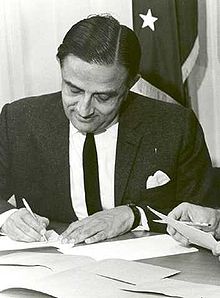Vikram Ambalal Sarabhai
| Vikram Sarabhai વિક્રમ સારાભાઈ |
|
|---|---|

Vikram Sarabhai
|
|
| Born |
12 August 1919 Ahmedabad, Bombay Presidency, British India |
| Died | 30 December 1971 (aged 52) Halcyon Castle, Kovalam in Thiruvananthapuram, Kerala, India |
| Nationality | Indian |
| Fields | Physics |
| Institutions |
Indian Space Research Organisation Physical Research Laboratory |
| Alma mater | Gujarat College, University of Cambridge |
| Doctoral advisor | Sir C. V. Raman |
| Known for |
Indian space program Indian Institute of Management Ahmedabad |
| Notable awards |
Padma Bhushan (1966) Padma Vibhushan (posthumously) (1972) |
| Spouse | Mrinalini Sarabhai (Hindi: मृणालिनी साराभाई) (classical dancer) |
| Children | Kartikeya Sarabhai |
Vikram Ambalal Sarabhai (12 August 1919 – 30 December 1971) was an Indian scientist and innovator widely regarded as the father of India's space programme. Sarabhai received the Shanti Swarup Bhatnagar Medal in 1962. The nation honoured him awarding Padma Bhushan in 1966 and Padma Vibhushan (posthumously) in 1972.
Son of Sheth Ambalal Sarabhai, he came from the famous Sarabhai family of India who were major industrialists committed to the Indian independence movement. Vikram Sarabhai married the classical dancer Mrinalini in 1942. The couple had two children. His daughter Mallika gained prominence as an actress and activist, and his son Kartikeya Sarabhai too became an active person in science. During his lifetime, he practiced Jainism and belonged to the Shrimal Jain community of Ahmedabad.
Known as the cradle of space sciences in India, the Physical Research Laboratory (PRL) was founded in 1947 by Vikram Sarabhai. PRL had a modest beginning at his residence, the RETREAT, with research on cosmic rays.
The institute was formally established at the M.G. Science Institute, Ahmedabad, on 11 November 1947 with support from the Karmkshetra Educational Foundation and the Ahmedabad Education Society. Prof. Kalpathi Ramakrishna Ramanathan was the first Director of the institute. The initial focus was research on cosmic rays and the properties of the upper atmosphere. Research areas were expanded to include theoretical physics and radio physics later with grants from the Atomic Energy Commission.
...
Wikipedia
